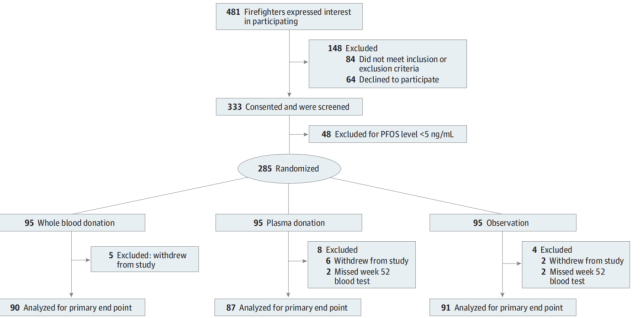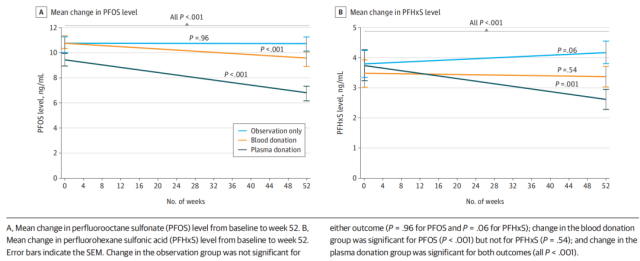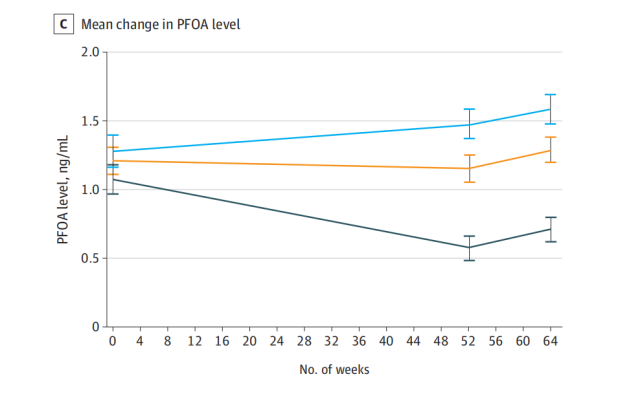Regular blood donation can effectively reduce the harmful fluoride in the blood
- Normal Liver Cells Found to Promote Cancer Metastasis to the Liver
- Nearly 80% Complete Remission: Breakthrough in ADC Anti-Tumor Treatment
- Vaccination Against Common Diseases May Prevent Dementia!
- New Alzheimer’s Disease (AD) Diagnosis and Staging Criteria
- Breakthrough in Alzheimer’s Disease: New Nasal Spray Halts Cognitive Decline by Targeting Toxic Protein
- Can the Tap Water at the Paris Olympics be Drunk Directly?
Regular blood donation can effectively reduce the harmful fluoride in the blood
- Should China be held legally responsible for the US’s $18 trillion COVID losses?
- CT Radiation Exposure Linked to Blood Cancer in Children and Adolescents
- FDA has mandated a top-level black box warning for all marketed CAR-T therapies
- Can people with high blood pressure eat peanuts?
- What is the difference between dopamine and dobutamine?
- How long can the patient live after heart stent surgery?
The world’s first clinical study found that regular blood donation can effectively reduce the harmful fluoride in the blood that is difficult to remove.
Affected by traditional concepts and some negative information about blood donation for a long time, people’s enthusiasm for blood donation has been affected.
As a result, the per capita blood donation rate in some countries is only 1%, and blood shortages have occurred in blood banks in various places.
If Singularity Cake tells everyone at this time that regular and appropriate blood donation can reduce the harmful chemicals in our blood, we wonder if everyone will be “blooded” and want to give it a try?
Perfluoroalkyl and polyfluoroalkyl compounds (PFAS) are a general term for a series of synthetic organic fluorides known as “permanent chemicals” because of their inability to degrade in the body, which are widely found in non-stick cookware, paint, Cleaning products, food packaging, and firefighting foam.
A growing number of studies have shown that high levels of PFAS in the blood are closely related to a variety of adverse health effects, including impaired immune function, abnormal thyroid function, obesity, altered liver function, and more.
In addition, multiple PFASs are associated with an increased risk of cancer [1].
However, there is currently no clinical intervention that can effectively reduce the level of PFAS in the blood.
Recently, Australian scientist Dr. Robin Gasiorowski and his team found in a world-first randomized clinical trials that regular blood or plasma donation can significantly reduce PFAS levels in the blood, and donating plasma is more effective, within a 12-month trial period. , plasma donation can reduce serum perfluorooctane sulfonic acid (PFOS) concentrations by approximately 30% [2].
This is the first time an intervention has been found that can effectively reduce the level of PFAS in the blood, and the related research results were published in JAMA Network Open .

Let’s take a look at how this research was carried out.
This was a 52-week open-label, randomized clinical trial of 285 Victorian Fire and Rescue workers (279 males, mean age 53) enrolled on the basis of PFAS levels in the firefighters’ blood, In particular, PFOS and perfluorohexyl sulfonic acid (PFHxS) are higher than the general population [3].
The conditions for inclusion are that the serum PFOS level is 5 ng/mL or above, the blood donation is eligible, and the blood has not been donated within 3 months before randomization.
Firefighters with a baseline PFOS level of 5 ng/mL or more were randomly assigned to a whole blood donation group (whole blood donation every 12 weeks for 1 year), a plasma donation group (plasma donation every 6 weeks for 1 year), and an observation group (observation only).
The primary endpoint of the study was the change in serum PFOS and PFHxS levels after 12 months in the plasma donation group or the whole blood donation group compared with the baseline and observation groups .
Secondary endpoints included changes in 26 other serum PFASs from baseline to Week 52 and from Week 52 to Week 64, as well as changes in complete blood count, biochemical markers, thyroid function, and lipid levels from screening to Week 52. Variety.

Participant Allocation Flowchart
Across the study, a total of 267 (93.7%) participants completed the entire trial, with participants in the plasma donation group completing an average of 6.4 plasma donations and participants in the whole blood donation group completing an average of 4.3 whole blood donations.
First, let’s take a look at the changes in serum PFOS levels .
The results of the analysis showed that the plasma donation group had a mean reduction in serum PFOS levels of 2.9 ng/mL (95% CI: -3.6 to -2.3 ng/mL;
P < .001) at the end of the 52-week trial compared with baseline levels, a decrease About 30% ;
the serum PFOS level in the whole blood donation group decreased by an average of 1.1 ng/mL (95% CI: -1.5 to -0.7 ng/mL;
P<0.001), while the serum PFOS level in the observation group at week 52 was significantly higher than that in the observation group. Baseline levels were not significantly different.
Compared with the observation group, the plasma donation group (-3.1ng/mL, 95%CI: -3.8 to -2.4ng/mL, P<0.001) and the whole blood donation group (-1.1ng/mL, 95%CI:- 1.7 to -0.5ng/mL, P<0.001) serum PFOS levels significantly reduced .
Among blood donors, the mean serum PFOS level in the plasma donor group was 2.0 ng/mL lower than that in the whole blood donor group (95% CI: -2.6 to -1.3 ng/mL, P<0.001).
What about changes in serum PFHxS levels?
Mean levels of PFHxS were significantly lower in the plasma donation group at the end of the 52-week trial compared with baseline levels (-1.1 ng/mL, 95% CI: -1.6 to -0.7 ng/mL, P<0.001), but not in the observation group.
Mean levels of PFHxS were not significantly different from baseline in the whole blood donation group and 0.4 ng/mL (95%CI: -0.01 to 0.7 ng/mL, P=0.06) in the observation group and decreased in the whole blood donation group 0.1 ng/mL (95% CI: -0.4 to -0.2 ng/mL, P=0.54).
Compared with the observation group, the mean levels of PFHxS in the plasma donation group ( P<0.001 ) and the whole blood donation group ( P=0.001 ) were significantly lower , and the mean level of PFHxS in the plasma donation group was 0.9 lower than the mean level of PFHxS in the whole blood donation group ng/mL (95% CI: -1.3 to -0.6 ng/mL, P<0.001).

Changes in mean levels of PFOS and PFHxS from baseline examination to 52 weeks
Next, we look at the associated results for secondary endpoints.
Secondary endpoints included 26 other PFASs, but only PFOA had sufficient data for analysis.
Mean levels of PFOA at week 52 were significantly lower in the plasma donation group (-0.5 ng/mL, 95% CI: -0.7 to -0.3 ng/mL, P = .001), and in the whole blood donation group, Mean levels of PFOA were not significantly different from baseline levels.
Compared with the observation group, the plasma donation group (-0.8ng/mL, 95%CI: -0.9 to -0.6ng/mL, P=0.001) and the whole blood donation group (-0.3ng/mL, 95%CI:- Mean serum PFOA levels from 0.4 to -0.1 ng/mL, P=0.007) were significantly lower than those at baseline, and the reduction was more pronounced in the plasma donation group.

Changes in PFOA levels observed during follow-up
Analysis of other secondary endpoints showed that the hemoglobin level of the whole blood donation group was significantly higher than that of the plasma donation group (0.51 g/dL, 95%CI: 0.72-0.29 g/dL, P=0.001) and the observation group (0.45 g/dL, 95% CI: 0.64-0.25 g/dL, P = 0.001) had a greater reduction in hemoglobin levels, and no significant differences were observed between groups in lipid levels and thyroid, liver, or kidney function test results.
In terms of safety, the incidence of adverse events in the plasma donation group and the whole blood donation group were 7.4% and 4.2%, respectively.
Overall, this world-first randomized clinical trial demonstrated that regular blood or plasma donation significantly reduced serum PFOS levels in participants with baseline PFOS levels of 5 ng/mL or more, with plasma donations being less than whole blood donations more obvious .
This difference may be due to the fact that the participants in the plasma donation group donated blood more frequently (every 6 weeks), and the level of PFAS in plasma is approximately twice the level of PFAS in blood, and plasma donation may be more effective in reducing the burden of PFAS on the body.
Notably, this is the first randomized clinical trial to systematically quantify whether donating plasma or blood can reduce serum PFAS levels. Given that PFAS is difficult to clear spontaneously, the results of this study may be an effective intervention for people with high PFAS levels.
Of course, more research is needed in the future to assess the clinical implications of these findings.
references:
1. Temkin AM, Hocevar BA, Andrews DQ, Naidenko OV, Kamendulis LM. Application of the Key Characteristics of Carcinogens to Per and Polyfluoroalkyl Substances. Int J Environ Res Public Health. 2020;17(5):1668. Published 2020 Mar 4 .doi:10.3390/ijerph17051668
2. Gasiorowski R, Forbes MK, Silver G, et al. Effect of Plasma and Blood Donations on Levels of Perfluoroalkyl and Polyfluoroalkyl Substances in Firefighters in Australia: A Randomized Clinical Trial. JAMA Netw Open. 2022;5(4):e226257. Published 2022 Apr 1. doi:10.1001/jamanetworkopen.2022.6257
3. Rotander A, Toms LM, Aylward L, Kay M, Mueller JF. Elevated levels of PFOS and PFHxS in firefighters exposed to aqueous film forming foam (AFFF). Environ Int. 2015;82:28-34. doi:10.1016/ j.envint.2015.05.005
The world’s first clinical study found that regular blood donation can effectively reduce the harmful fluoride in the blood that is difficult to remove.
(source:internet, reference only)
Disclaimer of medicaltrend.org
Important Note: The information provided is for informational purposes only and should not be considered as medical advice.



